Your Planets
Portraits of the Planets
Aspects between Planets
The planetary ages
The planetary families
Planets in Signs
The Planets in comics


These ten videos represent the geocentric cycles of the Sun, the Moon and the planets (for the latter, in direct or retrograde motion) in the Signs of the tropical zodiac with, in the background, the zodiacal or per-zodiacal constellations.
These ten videos represent the geocentric cycles of the Sun, the Moon and the planets. The ecliptic is the plane of the Sun’s apparent orbit around the Earth. The trajectories of the Moon and the planets are carried out on orbits more or less inclined on the ecliptic plane. In this ecliptic frame of reference, a planet is thus characterized by two coordinates: its ecliptic longitude (projection of its position on the ecliptic plane) calculated from 0° to 360° from 0° Aries and its ecliptic latitude (its north or south height relative to the same plane). By definition, the Sun has no ecliptic latitude.
The inclination of a planet’s orbital plane should not be confused with its ecliptic latitude. The inclination of its orbital plane to that of the ecliptic is specific to it, while its ecliptic latitude depends both on its position in its orbit and on its distance from the Earth.
The graphs below represent the orbital inclinations and the maximum ecliptic latitudes for the planets Venus & Mars:
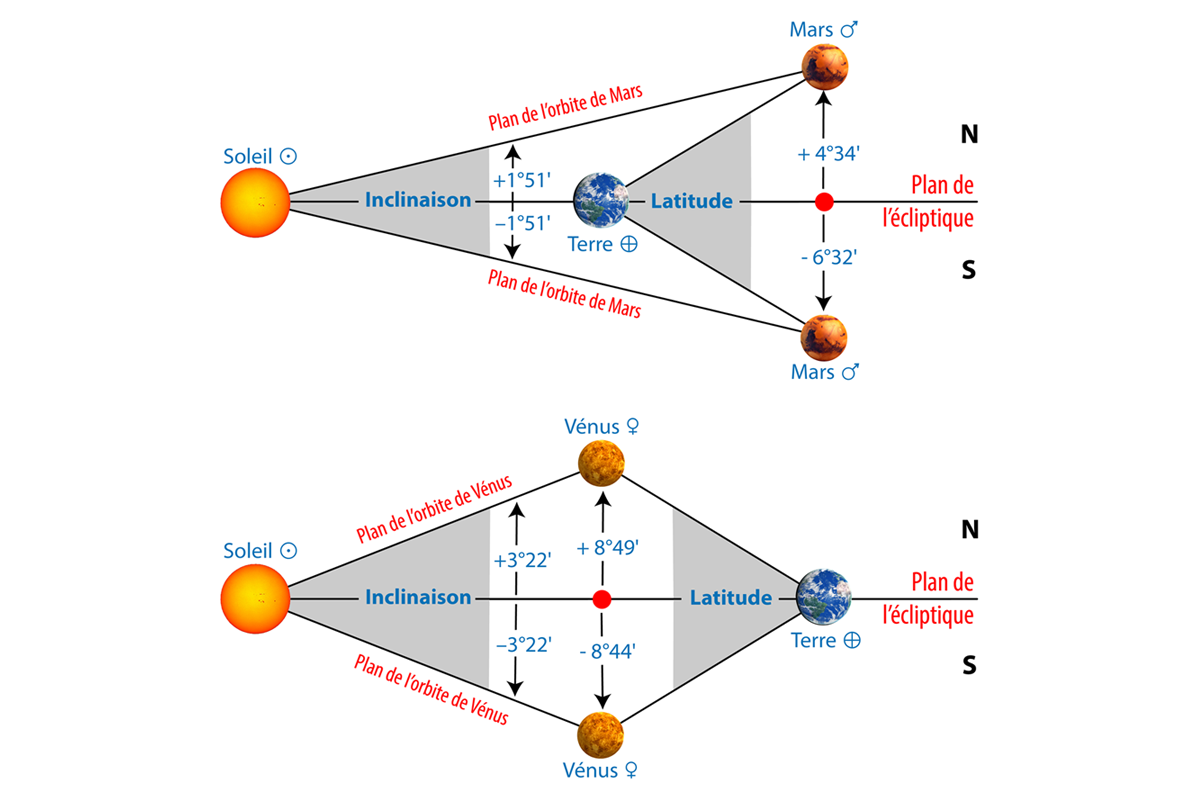
The table below summarizes the main information about ecliptic latitudes. The mentioned maximum ecliptic latitudes were calculated from the period 1500–2000.
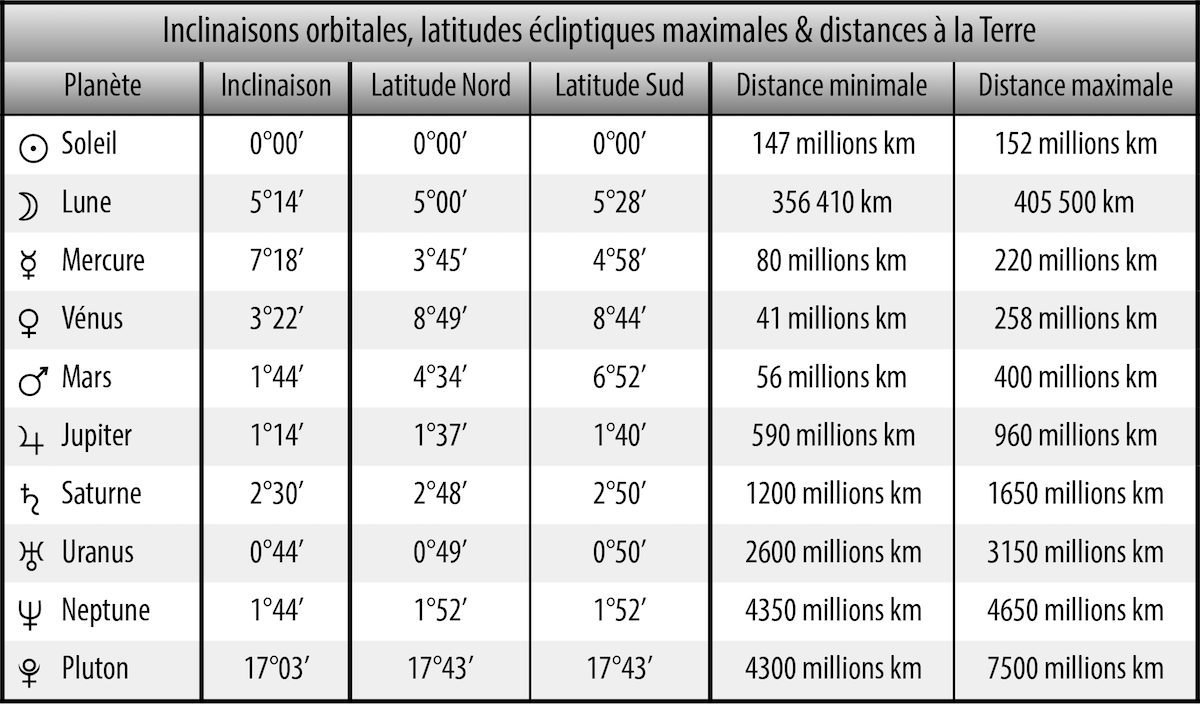
The planets move counter-clockwise or anticlockwise. However, they are periodically the object of a retrograde movement: they then seem to stop (first station) in their course then move clockwise or dextrogyrate (clockwise direction) before stopping at again (second station) and finally resume their run counter-clockwise. The cycle of retrogradations is indexed to that of synodic revolutions planets. The Sun and the Moon cannot have retrograde motion.
The graph below illustrates the retrogradation movement of an outer planet: heliocentric movements on the left, geocentric retrogradation loop on the right:
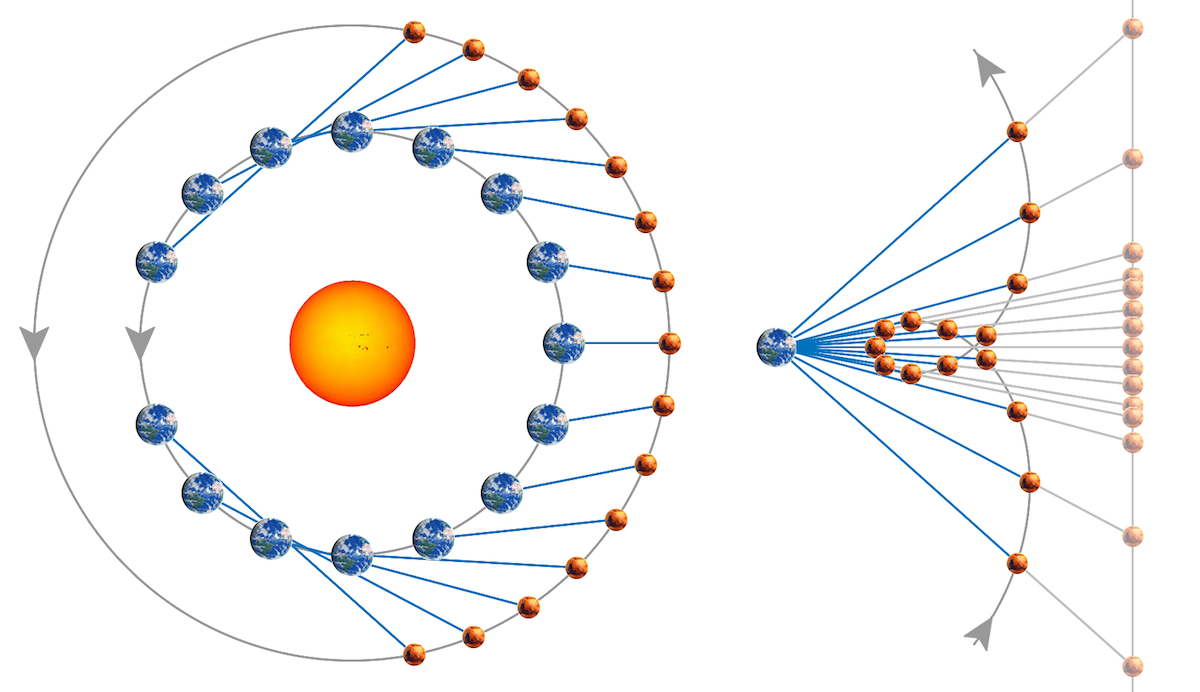
The table below gives information about the average synodic periods and the corresponding average retrogradation durations:
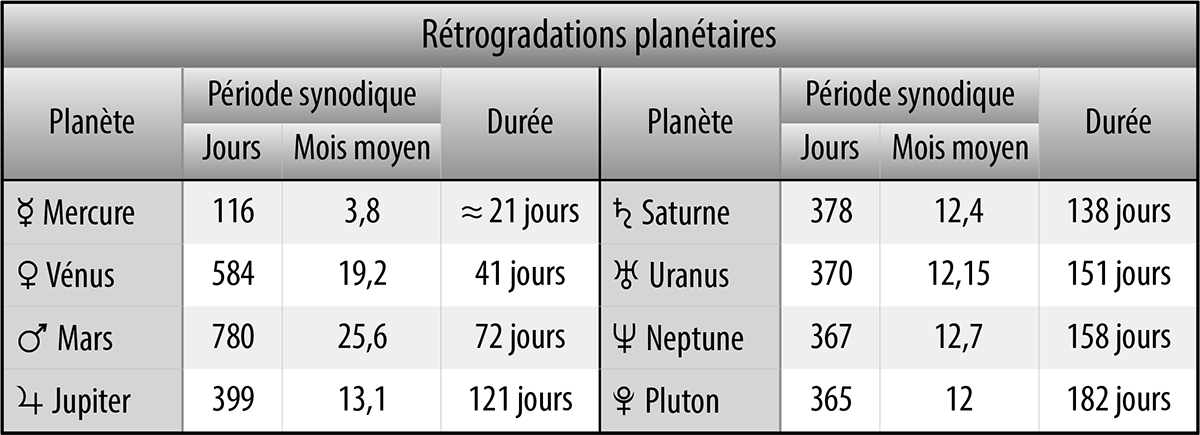
We distinguish the inner planets (between the orbit of the Earth and the Sun) and outer (from Mars). For an inner planet (Mercury & Venus), the apparent motion is direct, anterograde in superior conjunction (from a geocentric point of view it is then behind the Sun), and retrograde in lower conjunction (it is then in front of the Sun). Mercury is in lower conjunction every 116 Earth days on average (synodic period), but this interval can range from 105 days to 129 days, due to the very eccentric orbit of the planet.
Inner planet: example: retrogradation of Mercury. On average, when the Sun is around 18° in front of Mercury (following the direction of the Signs), Mercury in lower conjunction enters a period of retrogradation. It comes out of it, after the conjunction with the Sun at the heart of the retrogradation, when the latter is on average around 18° after Mercury.
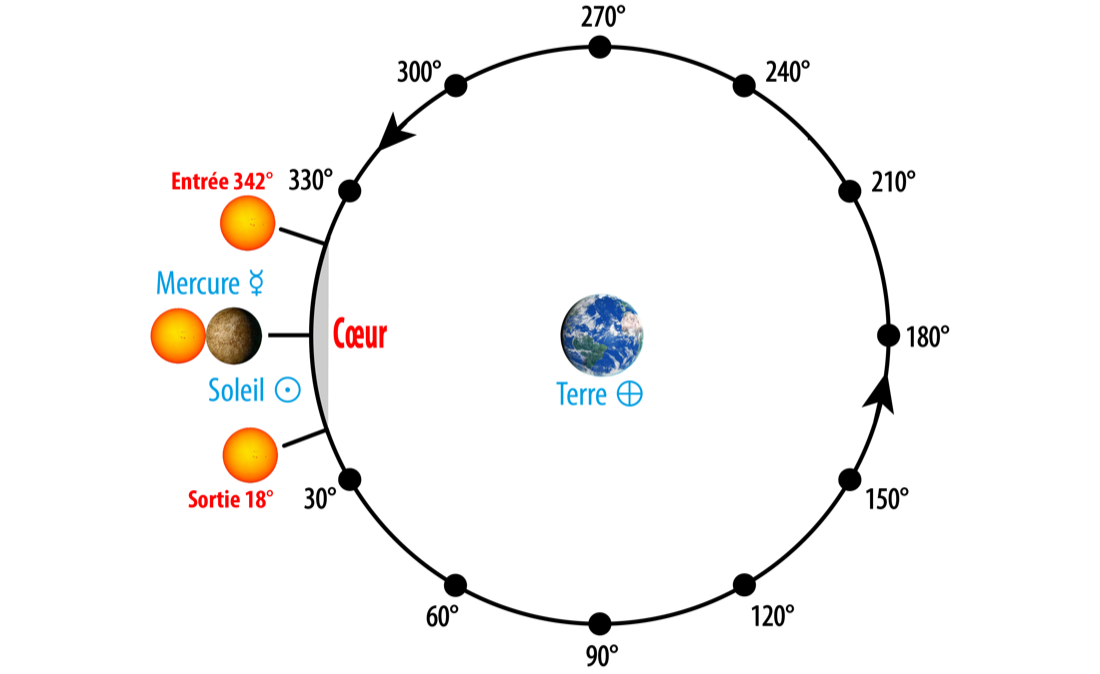
Outer planet: example: retrogradation of Mars. For an outer planet, the apparent motion is direct in conjunction with the Sun and retrograde in opposition to the Sun. On average, when the Sun is around 136° before Mars (according to the direction of the Signs), Mars enters a period of retrogradation. It comes out of it, after the opposition to the Sun at the heart of retrogradation, when the latter is around 136° after Mars.
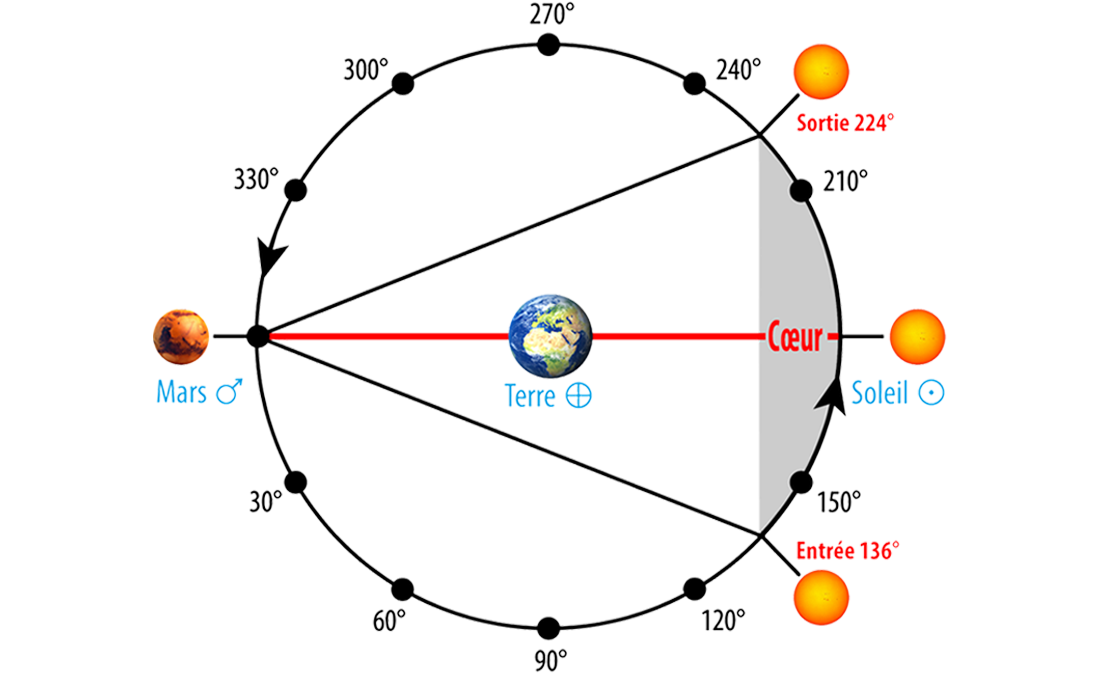
This apparent (and not illusory) movement of a planet results from the composition of its real movement and that of the Earth. It is explained to you in this article about retrogradations. You can view it on this animation from 4’08”.
Finally, note that the maximum ecliptic latitudes of a planet can be reached just before or just after its retrogradations.
These anterograde and retrograde movements occur in the foreground of a backdrop: the cosmic decor of the zodiacal constellations and those contiguous to them (constellations perizodiacal). For the U.A.I. (International Astronomical Union), both are grouped together within irregular polygons of variable dimensions. This stellar decor changes according to a periodicity of approximately 26,000 years due to the precession of the equinoxes. This periodic change has no direct effect on planetary retrogradations.
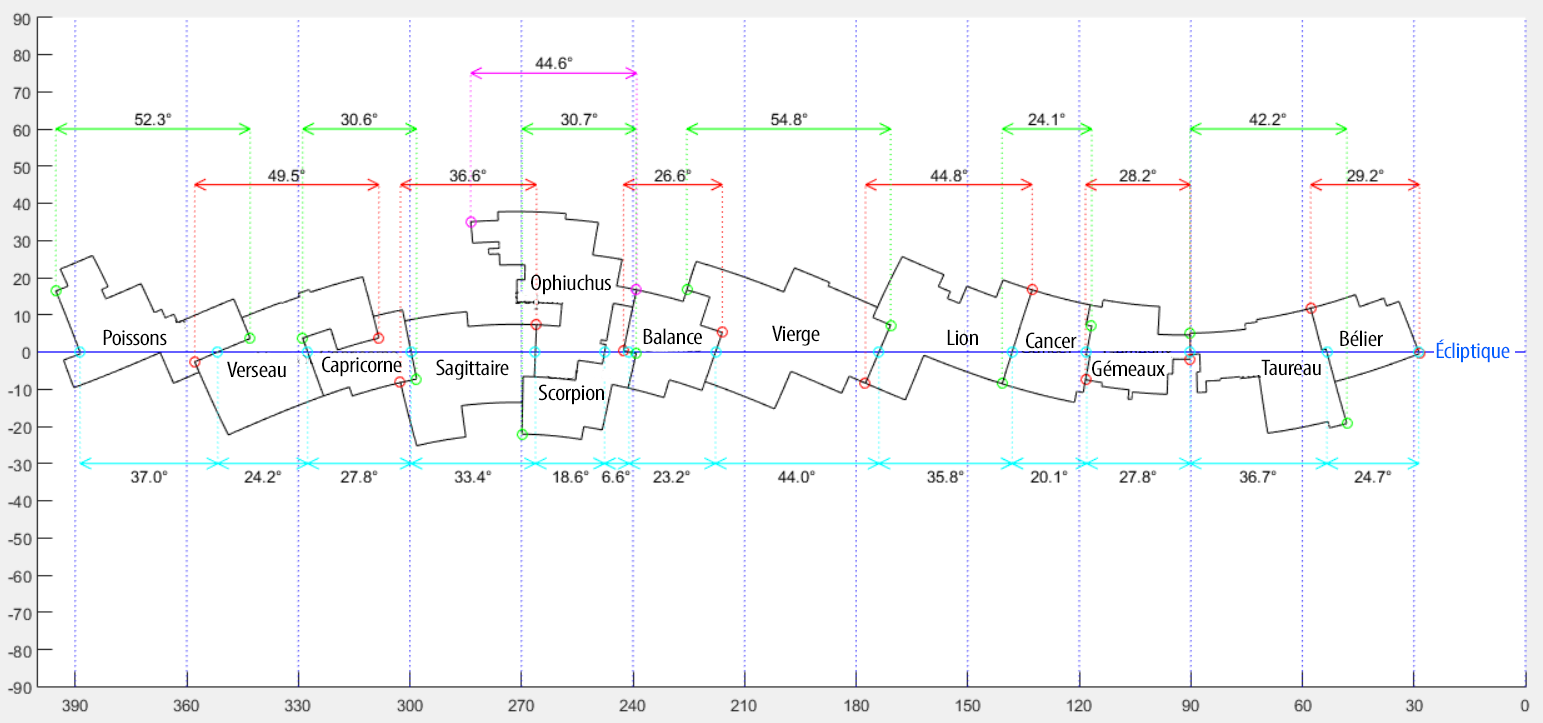
Due to the phenomenon of precession, none of these constellations remain in the same position with respect to the Signs of the astronomical zodiac. Furthermore, each of these constellations officially falls within an irregular bounding polygon with a different shape (these polygons may overlap) and therefore occupies a different width (L) in ecliptic longitude. You will find complete explanations about these stellar polygons in this article. See also video animations in Zodiac Signs & Constellations: Videos.
The following animations represent the geocentric cycles of the Moon, Sun and planets up to and including Pluto. For the stars with the fastest revolutions (from the Moon to Mars inclusive) the periods concerned range from 2023 to 2025. For the slow planets, the periods retained are 2023–2035 (Jupiter), 1996–2036 (Saturn), 2010–2095 (Uranus), 1861–2025 (Neptune) and 1821–2068 (Pluto).
Video captions:
▶ ecliptic plane: red horizontal axis
▶ ecliptic longitudes: horizontal graduations
▶ ecliptic latitudes: vertical tick marks
▶ minimum and maximum ecliptic latitudes: dashed horizontal lines
▶ start of retrograde movement: purple triangle
▶ end of retrograde movement: orange triangle
▶ official constellation boundaries: blue outlines
▶ constellation crossed by a planet: green outline
The Moon does not experience retrogradations, it is content to traverse its sinusoid tilted by approximately 5° on the plane of the ecliptic.
One second of video corresponds to one day in real time: the video therefore shows time accelerated by a factor of approximately 90,000.
The Sun only moves on the plane of the ecliptic, which is normal since this is that of its apparent orbit around the Earth.
One second of video is six days in real time, so the video shows time sped up by a factor of about 500,000.
There are 6 retrogradations of Mercury during the period concerned:
Retrogradation from 21/04/2023 to 15/05/2023:
▶ Start: ecliptic latitude = +2° 50′ N
▶ End: ecliptic latitude = −2° 38′ S
Retrogradation from 23/08/2023 to 15/09/2023:
▶ Start: ecliptic latitude = −4° 02′ S
▶ End: ecliptic latitude = −0° 59′ S
Mercury briefly passes through the perizodiacal constellation Sextant during its retrogradation.
Retrogradation from 13/12/2023 to 02/01/2024:
▶ Start: ecliptic latitude = +1° 49′ N
▶ End: ecliptic latitude = +3° 00′ N
Retrogradation from 05/04/2024 to 25/04/2024:
▶ Start: ecliptic latitude = +3° 11′ N
▶ End: ecliptic latitude = −1° 18′ S
Retrogradation from 05/08/2024 to 28/08/2024:
▶ Start: ecliptic latitude = −3° 47′ S
▶ End: ecliptic latitude = −2° 05′ S
Retrogradation from 27/11/2024 to 17/12/2024:
▶ Start: ecliptic latitude = −1° 09′ S
▶ End: ecliptic latitude = +2° 52′ N
One second of video is six days in real time, so the video shows time sped up by a factor of about 500,000.
Important: Maximum ecliptic latitudes can occur before or after periods of retrogradation. This is valid for all planets.
Venus only retrogrades once during the relevant period:
Retrogradation from 23/07/2023 to 04/09/2023:
▶ Start: ecliptic latitude = −3° 28′ S
▶ End: ecliptic latitude = −6° 53′ S
One second of video is six days in real time, so the video shows time sped up by a factor of about 500,000.
Mars only retrogrades once during the relevant period:
Retrogradation from 06/12/2024 to 24/02/2025:
▶ Start: ecliptic latitude = +2° 49′ N
▶ End: ecliptic latitude = +3° 42′ N
One second of video corresponds to twelve days in real time: the video therefore shows a time accelerated by a factor of approximately 1 million.
In the case of slow planets from Jupiter, retrogradations are more and more frequent: it is useless to list them all.
One second of video corresponds to one month in real time: the video therefore shows a time accelerated by a factor of about 3 million.
One second of video corresponds to two months in real time: the video therefore shows a time accelerated by a factor of about 5 million.
One second of video corresponds to six months in real time: the video therefore shows a time accelerated by a factor of approximately 16 million.
One second of video corresponds to one year in real time: the video therefore shows time accelerated by a factor of about 30 million.
We visualize here the strong inclination of Pluto’s orbit on the ecliptic, which corresponds to very important ecliptic latitudes and makes it repeatedly cross perizodiacal constellations:
Pluto in Aries ecliptic longitude:
▶ Because of its very high ecliptic latitude, it is in the perizodiacal constellation of the Whale that it moves;
Pluto in ecliptic longitude Taurus:
▶ Because of its very high ecliptic latitude, it is in the perizodiacal constellation of the Whale that it moves, then in that of Taurus;
Pluto in Gemini ecliptic longitude:
▶ Because of its strong ecliptic latitude, it is in the constellation of Taurus that it moves, then in that of Orion, per-zodiacal;
Pluto in ecliptic longitude Cancer:
▶ It is in the perizodiacal constellation of Orion that he moves, then in that of Gemini, and finally briefly that of Cancer;
Pluto in ecliptic longitude Leo:
▶ It is in the constellation of Cancer that it moves during this period, then about halfway in that of Leo;
Pluto in ecliptic longitude Virgo:
▶ It is in the constellation of Leo that it moves during almost all this period, then in that of Virgo after having briefly passed through that, perizodiacal, of the Hair of Berenice because of its high ecliptic latitude;
Pluto in ecliptic longitude Libra:
▶ It is in the per-zodiacal constellation of Berenice’s Hair that it moves at the beginning of this period because of its high ecliptic latitude, then in that of Virgo after a brief passage in that, per-zodiacal, of Bouvier always for the same reason;
Pluto in Scorpio ecliptic longitude:
▶ It is in the constellation of Virgo that it moves at the beginning of this period because of its high ecliptic latitude, then in that of Libra after a brief passage in that, perizodiacal, of the Head of the Serpent always for the same reason;
Pluto in Sagittarius ecliptic longitude:
▶ It is in the constellation of the Serpentarius that it moves at the beginning of this period because of its strong ecliptic latitude, then in that, per-zodiacal, of the Tail of the Serpent after which it quickly crosses a portion of that of Sagittarius;
Pluto in ecliptic longitude Capricorn:
▶ It is in the constellation of Sagittarius that he moves almost exclusively, except at the end for a brief incursion into that of Capricorn;
Pluto in ecliptic longitude Aquarius:
▶ It is in the constellation of Capricorn that it moves almost exclusively, after which it ends this journey in that of Aquarius;
Pluto in ecliptic longitude Pisces:
▶ It is in the constellation of Aquarius that it moves almost exclusively, after which it ends this journey in that, perizodiacal, of the Whale.
One second of video corresponds to one year in real time: the video therefore shows time accelerated by a factor of about 30 million.
A retrogradation produces at least two characteristic effects:
▶ 1) The extended station of the retrograde planet in a portion of the zodiac;
▶ 2) Inversion of the photoperiodic rhythm of the retrograde planet.
The first effect immediately brings us back to one of the characteristics of conditioning: the longer a signal lasts, the more its perception by the nervous system intensifies and the more it is likely to react. This effect is particularly noticeable during periods of planetary transits. Transits of fast non-retrograde planets last for a short time. Assuming (arbitrarily) an orb of 10° before and after the exact conjunction or opposition aspect in transit, a transit of the Moon (which cannot be retrograde) lasts only one day and a transit of Mercury one ten days. On the other hand, a retrograde Mercury can transit for about a month on a natal planet…
In the natal chart, one can wonder if one of the effects of a planetary retrogradation (especially if it is a fast and dominant planet) would not be to accentuate the importance of the Sign where it is located. find. Indeed, she remains longer in this Sign during the post-natal period.
The second effect requires trying to deal rationally with the interaction between the effects of the “normal” Sign and those of the “abnormal” Sign (in photoperiod) induced by retrogradation.
The table below summarizes information regarding the zodiac effects of retrogradations. The “Phase D-N” column provides information on the ratio of daytime (white circle) and nighttime (black circle) durations. It reads: A retrograde planet in Aries has similar effects to a planet in Virgo for the duration of its retrogradation. Indeed, in Aries the diurnal arc noticeably dominant in duration is increasing, whereas due to retrogradation it is decreasing, as in Virgo.
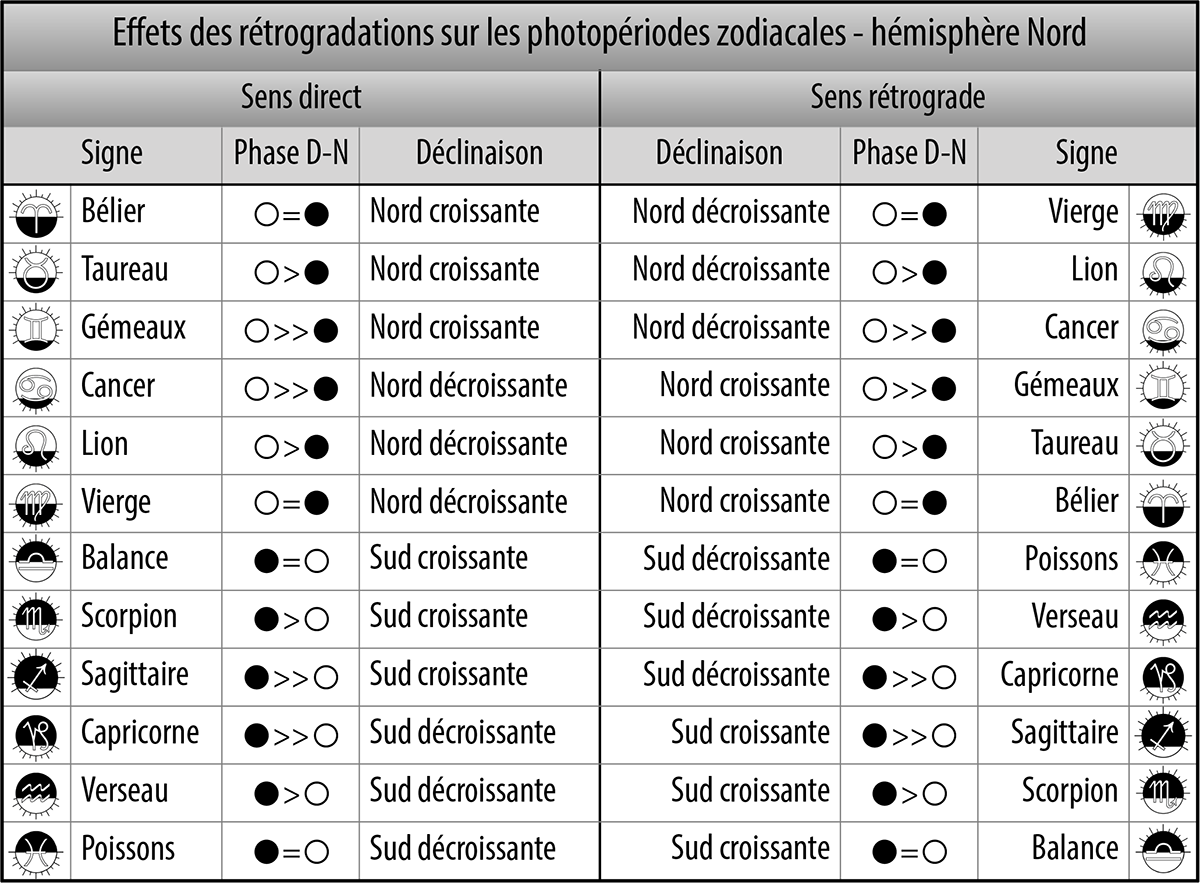
Example: Mercury in Sagittarius. For an average or higher terrestrial latitude in the northern hemisphere, it is characterized by a growing nocturnal arc much greater in duration compared to the diurnal arc. But during his period of retrogradation in this Sign, the same dominant nocturnal arc in duration is decreasing: he therefore then has the characteristics of a Mercury in Capricorn.
In this case, should we interpret a Mercury-Capricorn rather than a Mercury-Sagittarius? It is not so simple. As Jean-Pierre Nicola points out, “changing Sign because the declination goes from growth to decrease or the opposite because of retrogradation, it is to eradicate the component right ascension of the position of the star (hence an absurdity) and isolate the retrogradation, extract it as a phenomenon apart from the synodic revolution. A vehicle which, on a hill, reverses, is not a vehicle which rises, nor a vehicle which takes a leap in time to return to the past. Retrogradation is part of a cycle. It is enough to take the trouble to draw a graph of variation of declination (other than Sun, Moon) to understand and visualize the retrogradation by an ‘anomaly’ on the average curve.”
One of the most attractive hypotheses is proposed by Jean-Pierre Nicola: “retrogradation may accentuate ‘the phase effect’ since it remains common to the Signs concerned… Not sure that it is an exclusively negative effect.” These hypotheses are explored in the article Retrogradations and declinations. In this hypothesis, the Capricornian effects of the Mercury-Sagittarius retrogradation would accentuate the Sense of Syntheses and the ultraparadoxical phase peculiar to the Solstitial Signs.
Observation seems to show that the main effect of a retrogradation is an oscillation, an alternation between the characteristics of the “normal” Sign (Sagittarius) and those of the “abnormal” Sign (Capricorn), these fluctuations can be adapted or unadapted, “positive” or “negative”. In any case, we do not observe any of the systematically negative effects attributed to retrograde planets by traditional astrology, such as reduced efficiency, inertia or paralysis, not to mention the delusions they inspire in karmic astrology.
Simulations created by Julien Rouger with free software Stellarium. Texts by Richard Pellard.
▶ The zodiac and the precession of the equinoxes
▶ Your zodiac Sign
▶ Signs and seasons
▶ Planetary trios in Signs
▶ The world according to Claudius Ptolemy, astronomer-astrologer and lighthouse of Alexandria
▶ The astronomical reality of the zodiac
▶ The human reflexology zodiac
▶ Autour du zodiaque : de l’eau dans un Signe de Feu ?
▶ Zodiaque et sphère locale
▶ Mythologie du zodiaque
▶ Zodiaque et formes de l’inhibition
▶ Do we change character by changing Sun sign?
▶ Énergie-Espace-Temps-Structure et zodiaque
▶ Genèse du zodiaque conditionaliste
▶ L’horloge photopériodique du genou
▶ Sun Sign and Rising Sign
▶ Astrologie, adaptation & inadaptation
▶ Les rythmes du zodiaque
▶ Simplified cosmography of the solar system
▶ Thème de domitude et hiérarchisation planétaire
▶ Effets et contre-effets des images et représentations sur les faits et les idées
▶ Le taijitu dans le système solaire
▶ Zodiac, planets and Jungian typology
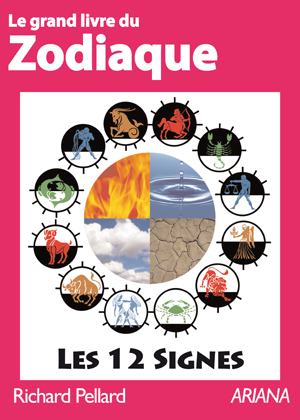
Le grand livre du zodiaque
par
180 pages. Illustrations en couleur.
Ce livre présente et explique les trois zodiaques : celui du décor des constellations, celui de l’astrologie traditionnelle basé sur les Quatre Éléments symboliques (Feu, Terre, Air & Eau) et celui de l’astrologie naturelle basé sur les phénomènes astronomiques objectifs.
Téléchargez-le dès maintenant dans notre boutique